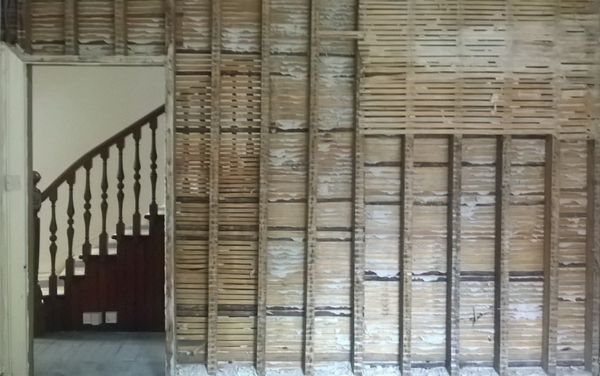Lath and plaster
Lath and plaster is a technique which was used to finish interior walls and ceilings from the early-18th until the early-to-mid-20th century. It was then generally superseded by drywall techniques and plasterboard.
The process involved laths (thin strips of timber) nailed to timber joists or posts and then covered with built-up layers of plaster. Laths typically measure 25 mm x 6 mm, and are positioned about 6 mm apart from each other to allow the plaster to penetrate into the gaps between them.
Typically three coats of plaster would then be applied:
- A ‘render’ layer about 6 mm thick to bond to and fill the gaps between the laths.
- A ‘floating’ layer about 6 mm thick to provide a relatively smooth surface for the third layer.
- A ‘setting’ layer about 3 mm thick to provide a completely smooth finish for decoration.
The first and second layers typically used a 1:3 lime putty to clean, sharp sand mixture. Animal hair was often added to assist with binding. The mixture for the third layer was usually a 3:1 lime putty to fine sand mixture or lime putty on its own.
As time went on, gypsum or cement was added which helped to reduce the setting time between layers.
The advantage of using lath was that it allowed for ornamental or decorative shapes, and could provide sound insulation and fire resistant properties.
However, it was a skilled craft and was a time-consuming activity and so was largely replaced by the use of pre-manufactured plasterboard towards the middle of the 20th century.
[edit] Related articles on Designing Buildings
Featured articles and news
RTPI leader to become new CIOB Chief Executive Officer
Dr Victoria Hills MRTPI, FICE to take over after Caroline Gumble’s departure.
Social and affordable housing, a long term plan for delivery
The “Delivering a Decade of Renewal for Social and Affordable Housing” strategy sets out future path.
A change to adoptive architecture
Effects of global weather warming on architectural detailing, material choice and human interaction.
The proposed publicly owned and backed subsidiary of Homes England, to facilitate new homes.
How big is the problem and what can we do to mitigate the effects?
Overheating guidance and tools for building designers
A number of cool guides to help with the heat.
The UK's Modern Industrial Strategy: A 10 year plan
Previous consultation criticism, current key elements and general support with some persisting reservations.
Building Safety Regulator reforms
New roles, new staff and a new fast track service pave the way for a single construction regulator.
Architectural Technologist CPDs and Communications
CIAT CPD… and how you can do it!
Cooling centres and cool spaces
Managing extreme heat in cities by directing the public to places for heat stress relief and water sources.
Winter gardens: A brief history and warm variations
Extending the season with glass in different forms and terms.
Restoring Great Yarmouth's Winter Gardens
Transforming one of the least sustainable constructions imaginable.
Construction Skills Mission Board launch sector drive
Newly formed government and industry collaboration set strategy for recruiting an additional 100,000 construction workers a year.
New Architects Code comes into effect in September 2025
ARB Architects Code of Conduct and Practice available with ongoing consultation regarding guidance.
Welsh Skills Body (Medr) launches ambitious plan
The new skills body brings together funding and regulation of tertiary education and research for the devolved nation.
Paul Gandy FCIOB announced as next CIOB President
Former Tilbury Douglas CEO takes helm.
UK Infrastructure: A 10 Year Strategy. In brief with reactions
With the National Infrastructure and Service Transformation Authority (NISTA).























